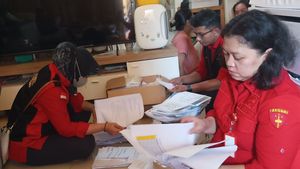JAKARTA - NASA's Perseverance rover has just sent a panoramic image of a sample depot recently completed on Mars. The sample depot is an important milestone for the mission and the collection of the first human samples on another planet.
Panorama, combined with 368 images sent to Earth, captured the placement and mapping of 10 carefully-made titanium tubes for more than a month.
Eight of the tubes were filled with rock and regolith (rock and dust fragments), while one was an atmospheric sample and the other was a witness tube.
Perseverance photographed the depot using a Mastcam-Z camera at the top of its pole, or head on January 31. The color has been adjusted to show the surface of Mars roughly as seen by the human eye.
The depot represents a collection of recoverable sample reserves in the future through the Mars Sample Return campaign, a joint effort between NASA and the European Space Agency (ESA) aimed at bringing samples of Mars to Earth for study.
The rover began building the depot on December 21 last year, and set the tube distance to make it easier to pick up later.
The main tube is in Perseverance's stomach, along with future samples taken during the mission to the Sampling Lander as part of the campaign.
If something happens to the rover robot to prevent it from sending the tube directly to the lander, the sample can be taken from the depot.
For information, Perseverance builds a depot in the Three Forks area, a location within the Jezero Mars Crater.
Billions of years ago, it was a river flowing into the crater, carrying sediment forming a fan-shaped steep delta that would be climbed by a rover robot in the coming months.
Mars' current surface is cold, dry, and generally not friendly to life, ancient Mars is most likely similar to Earth and can support microbial life, if anything has ever formed on the Red Planet.
The samples Perseverance collects can help scientists determine whether life ever leaves its mark in a place like the Jezero Crater. This was quoted from NASA's official website, Thursday, February 16.
The English, Chinese, Japanese, Arabic, and French versions are automatically generated by the AI. So there may still be inaccuracies in translating, please always see Indonesian as our main language. (system supported by DigitalSiber.id)













